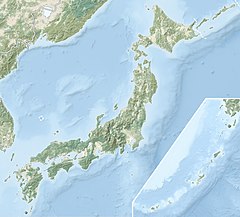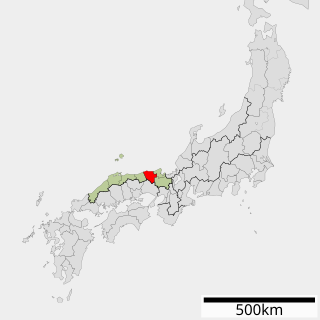
Tajima Province was a province of Japan in the area of northern Hyōgo Prefecture. Tajima bordered on Tango and Tanba to the east, Harima to the south, and Inaba to the west. Its abbreviated form name was Tanshū (但州). In terms of the Gokishichidō system, Tajimao was one of the provinces of the San'indō circuit. Under the Engishiki classification system, Tajima was ranked as one of the "superior countries" (上国) in terms of importance, and one of the "near countries" (近国) in terms of distance from the capital. The provincial capital was located in what is now the city of Toyooka. The ichinomiya of the province is the Izushi Shrine also located in Toyooka. The area of the province was 2099.01 square kilometers.

Ōasahiko Shrine is a Shinto shrine in the Ōasachō-Bandō neighborhood of the city of Naruto, Tokushima Prefecture, Japan. It is one of the shrines claiming the title of ichinomiya of former Awa Province. The main festival of the shrine is held annually on November 1.

The Okuni Shrine, is a Shinto shrine in the town of Mori, Shūchi District, Shizuoka Prefecture, Japan. It is one of the two shrines claiming the title of ichinomiya of former Tōtōmi Province. The main festival of the shrine is held annually on April 18.

Takebe Shrine is a Shinto shrine located in the city of Ōtsu, Shiga Prefecture, Japan. It is the ichinomiya of former Ōmi Province. The main kami enshrined are Ōkuninushi and Yamato Takeru. The shrine's main festival is held annually on April 15.

Awa Shrine is a Shinto shrine in the Daijingū neighborhood of the city of Tateyama in Chiba Prefecture, Japan. It is one of two shrines claiming to hold the title of ichinomiya of former Awa Province. The main festival of the shrine is held annually on August 10.

Tamasaki Jinja (玉前神社) is a Shinto shrine in the Ichinomiya neighborhood of the town of Ichinomiya in Chōsei District, Chiba Prefecture, Japan. It is the ichinomiya of former Kazusa Province. The main festival of the shrine is held annually on September 13, and features kagura performances, which are listed as an Intangible Cultural Property of Chiba Prefecture
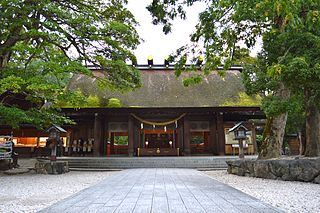
Kono Jinja (籠神社) is a Shinto shrine in the Ōgaki neighborhood of the city of Miyazu in Kyoto Prefecture, Japan. It is the ichinomiya of former Tango Province. The main festival of the shrine is held annually on April 24.The shrine is also called the Moto-Ise Kono Jinja (元伊勢籠神社), and its kannushi has been in the Amabe clan since the Kofun period.

Toga Shrine is a Shinto shrine in the city of Toyokawa in eastern Aichi Prefecture, Japan. It is the ichinomiya of former Mikawa Province. The main festival of the shrine is held annually from May 3 to May 5. Located on the borderland of Aichi with Shizuoka Prefecture, the summit of Mount Hongū 782 metres (2,566 ft) is a sacred mountain considered to be within the precincts of the shrine, and has a subsidiary chapel.

Sasamuta Jinja (西寒多神社) is a Shinto shrine in the Soda neighborhood of the city of Ōita in Ōita Prefecture, Japan. It is one of the shrines claiming to be the ichinomiya of former Bungo Province. The main festival of the shrine is held annually on April 15.

Kehi Shrine is a Shinto shrine located in the Akebono-chō neighborhood of the city of Tsuruga, Fukui Prefecture, Japan. It is the ichinomiya of former Echizen Province. The main festival of the shrine is held annually on September 4. The shrine is considered the chief guardian shrine of the Hokuriku region.

Izanagi Jingū (伊弉諾神宮) is a Shinto shrine in the Taga neighborhood of the city of Awaji in Hyōgo Prefecture, Japan. It is the ichinomiya of former Awaji Province. The main festival of the shrine is held annually on April 22.

Chiriku Hachiman Shrine is a Shinto shrine in the Shirakabe neighborhood of the town of Miyaki in Saga Prefecture, Japan. It is one of the shrines claiming to be the ichinomiya of former Hizen Province. The main festival of the shrine is held annually on March 15.
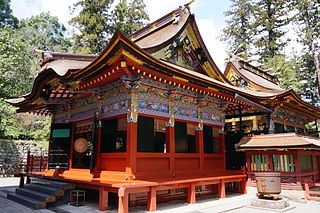
Nukisaki Jinja (貫前神社) is a Shinto shrine in the Ichinomiya neighborhood of the city of Tomioka in Gunma Prefecture, Japan. It is the ichinomiya of former Kōzuke Province. The main festival of the shrine is held annually on March 15. It is one of only three shrines in all of Japan where visitors enter from the top and descend downwards into the shrine; the other two are Udo Shrine and Kusakabe Yoshimi Shrine in Miyazaki and Kumomoto Prefectures respectively. Nukisaki Shrine is also featured on the 'yu' card in Jomo Karuta.

Tsubaki Shrine (都波岐神社) is a Shinto shrine in the Ichinomiya neighborhood of the city of Suzuka in Mie Prefecture, Japan. It is one of the two shrines which claim the title of ichinomiya of former Ise Province. The main festival of the shrine is held annually on October 10. It is also known as the Tsubaki-Nakato Jinja (都波岐奈加等神社), as the shrine consisted of two separate shrines, the Tsubaki Jinja and the Nakato Jinja, which were amalgamated in the Meiji period.

Ono Jinja (小野神社) is a Shinto shrine in the Ichinomiya neighborhood of the city of Tama in Tokyo Metropolis, Japan. It is one of the two shrines claiming the title of ichinomiya of former Musashi Province. The main festival of the shrine is held annually on the second Sunday of September. During the Edo Period, it was also called the Ichinomiya Daimyōjin (一宮大明神).

Susaki Shrine is a Shinto shrine in the Susaki neighborhood of the city of Tateyama in Chiba Prefecture, Japan. It is one of two shrines claiming to hold the title of ichinomiya of the former Awa Province. The main festival of the shrine is held annually on August 20.
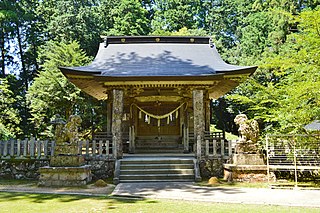
Awaga Jinja (粟鹿神社) is a Shinto shrine in the Santocho Awaga neighborhood of the city of Asago in Hyōgo Prefecture, Japan. It is one of the two shrines which claim the title of ichinomiya of former Tajima Province. The main festival of the shrine is held annually on October 17.

Izumo Daijingū (出雲大神宮) is a Shinto shrine in the Chitose neighborhood of the city of Kameoka in Kyoto Prefecture, Japan. It is the ichinomiya of former Tanba Province. The main festival of the shrine is held annually on the October 21.

Tamura Jinja (田村神社) is a Shinto shrine in the Ichinomiya neighborhood of the city of Takamatsu in Kagawa Prefecture, Japan. It is the ichinomiya of former Sanuki Province. The main festivals of the shrine are held annually on May 8 and October 8. It is located approximately 7 km south of downtown Takamatsu. The area has abundant spring water, and the shrine is based on the worship of the god of water and the shrine's inner shrine is built over a spring. The name 'Tamura' is based on locale, and has no relationship with Sakanoue no Tamuramaro like other shrines of the same name in other parts of Japan.

Tamanooya Jinja (玉祖神社) is a Shinto shrine in the Ōsaki neighborhood of the city of Hōfu in Yamaguchi Prefecture, Japan. It is the ichinomiya of former Suō Province. The main festival of the shrine is held annually on the Saturday & Sunday nearest September 25.



